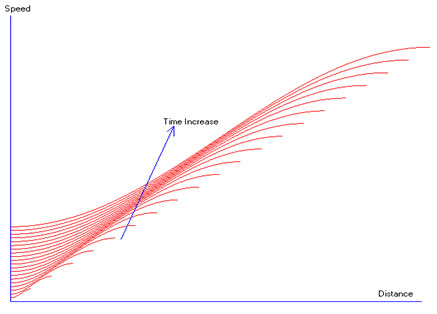Local Speed
As described before, time has its maximum
value at the center of the world and decreases by distance from this center, so
the formula-24 is a good approximation.
It is clear that at center of the world the velocity
of any object mathematically is zero after some moments of creation, and would
be at maximum value at the edge of expansion wave, so formula 23 is accepted.
But Sf cannot be zero at center, and as time increases this speed
also increases.
While the world is expanding (since number
of Omegas is limited and TAs and materials formation begins) distance between
successive Omegas will reach to a stable value, and also Δt become very small, so Sf would not be defined as Sm
(formula 23) and would be as the following figure.

Fig.32- Sf will change during the world formation
This means the light speed at center increases by time, and formula 23 could be modified to

Galaxies and stars at any position have speed much less than true light speed; in fact any material containing Gravita would not follow Sm speed. Stars and galaxies have not such speed. These items have a negative acceleration toward center which follows general gravity theorem. This acceleration could be computed from the following formula.

G is the equivalent Universal Newton gravity coefficient. It is clear that G is also a function of speed of light or better said Sf, that means G has its maximum at zero speed but would be zero at Sf. Also it has maximum value as zero distance to the world center and is zero at the world horizon.
G = Gmax * Cos (t * Π/ Tf) × Cos (Π / 2 * d / R)
Considering the world expansion acceleration Aw
Aw= Sfmax * Π/Tf * Cos (t * Π / Tf)
Then the total acceleration would be
A = Aw + Al
During creation of the world some of linear energy of Omegas are converted to rotational energy and speed of sub particles would not follow Sf ,specially it occurs when galaxies are created, it is clear that their speed are much less, but light speed is a local function and depends to distance from the world center.